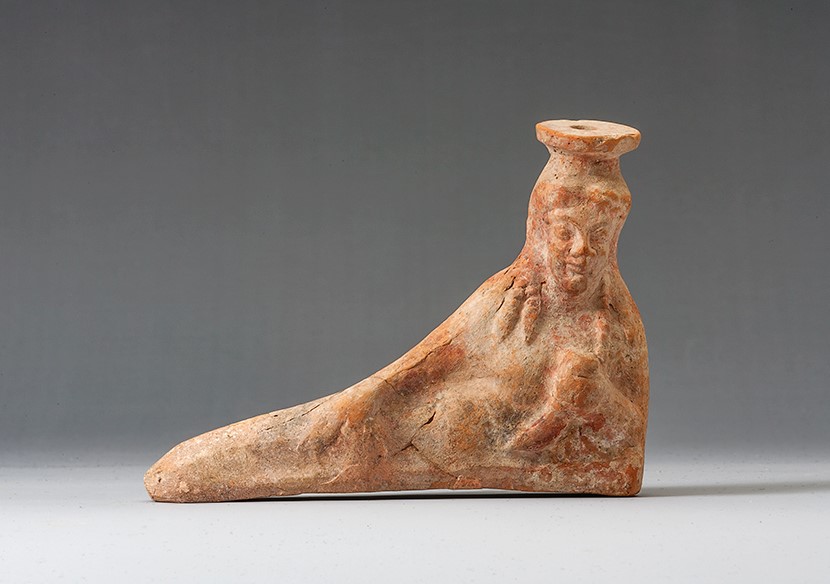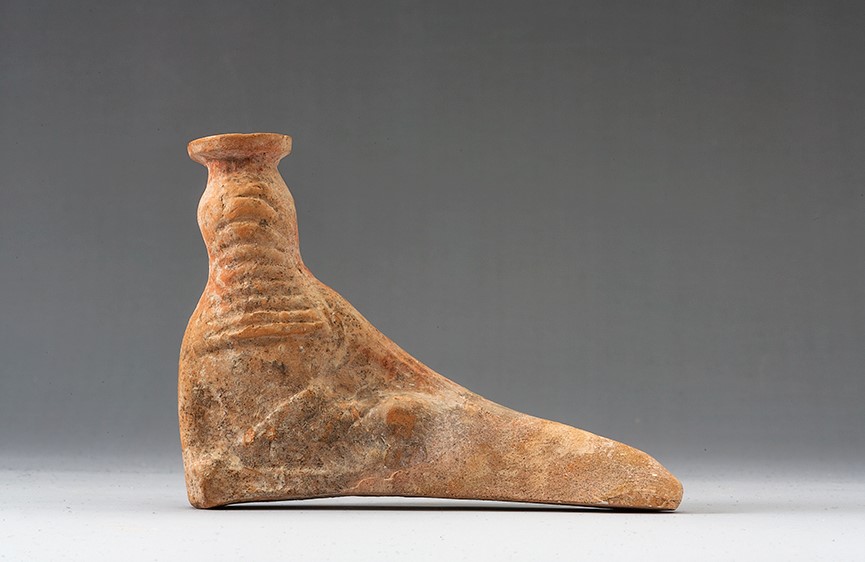Acquisition number: 1979.04
Terracotta Moulded Vase.
Reconstructed from fragments but without serious restoration except for the lower legs of the figure. Somewhat orange, micaceous clay. The vase is moulded both front and back; the join between the front and back halves has been pared smooth. The base was added as a separate flat sheet of clay, pared smooth along the joins. The mouth is that of an aryballos - in the form of a flat disc. There are traces of red paint on the upper part of the figure’s body and on the drinking horn; there are remains of dark paint over the lower body and legs.
The figure is that of a reclining banqueter. He leans on his left elbow and has a drinking horn in his left hand. His right hand comes across to rest on his right knee. He wears a long chiton although it is not distinguished in any detail. He has long hair which comes forward over the shoulders and at the back is treated in wig-like fashion with a series of horizontal grooves. It finishes in a straight line at the bottom. The facial features are clearly delineated with further detailing after removal from the mould. There are traces of a cushion under the left elbow.
Title: Terracotta Moulded Vase - 1979.04
Acquisition number: 1979.04
Author or editor: J.R. Green
Culture or period: East Greek.
Date: Mid to late 6th century BC.
Material: Clay - Terracotta
Object type: Vase
Dimensions: 149mm (l) × 110mm (h)
Origin region or location: Greece
Origin city: Possibly Rhodes.
Display case or on loan: 3
Keywords: Greek, East Greek, Moulded vase, Plastic vase, Bomford Collection, symposion, symposium
Sotheby (London), Sale Cat., 13 July 1970, no. 90 (ill.); Catalogue of Ancient Glass, Jewellery and Terracottas from the Collection of Mr and Mrs James Bomford (Exhib. Cat. Ashmolean Museum Oxford, 20 November - 12 December 1971) no. 106; Sotheby (London), Sale Cat., 10 July 1979, no. 205 (ill.).
1979.04
Terracotta Moulded Vase
Purchased; formerly in the Bomford collection. Ht 11cm; max. length as reconstructed ca 14.9cm.
Reconstructed from fragments but without serious restoration except for the lower legs of the figure. Somewhat orange, micaceous clay. The vase is moulded both front and back; the join between the front and back halves has been pared smooth. The base was added as a separate flat sheet of clay, pared smooth along the joins. The mouth is that of an aryballos - in the form of a flat disc. There are traces of red paint on the upper part of the figure’s body and on the drinking horn; there are remains of dark paint over the lower body and legs.
The figure is that of a reclining banqueter. He leans on his left elbow and has a drinking horn in his left hand. His right hand comes across to rest on his right knee. He wears a long chiton although it is not distinguished in any detail. He has long hair which comes forward over the shoulders and at the back is treated in wig-like fashion with a series of horizontal grooves. It finishes in a straight line at the bottom. The facial features are clearly delineated with further detailing after removal from the mould. There are traces of a cushion under the left elbow.
Moulded or ‘plastic’ vases were popular at one stage or another in most areas of the ancient world, notably East Greece, Corinth, Athens and Sicily. Compare the Athenian ‘head-vase’ 1968.21, or the vessel in the form of an actor-figurine, 1979.05. For another banqueter, probably heroic or divine, compare the Tarentine figurine 1981.03.
The wine-banquet or symposion began to form an integral and characteristic part of Greek culture from probably as early as the eighth century bc. It came to involve special rooms and special equipment (e.g. the black-figure ‘Little Master’ cups such as are discussed elsewhere in this catalogue), as well as special poetry and song. Until the fourth century, it was mainly (so far as we can tell) an aristocratic or upper-class activity, and its exclusiveness tended to foster the bonds between them. There is now a very large literature on the subject. For a good overview, see the articles collected in O. Murray (ed.), Sympotica. A Symposium on the Symposion (Oxford 1990), with its references to earlier work. For the symposion in art, see also F. Lissarrague, The Aesthetics of the Greek Banquet (Princeton 1990). It is also worth remembering that the drinking of wine and the symposion were one of the more significant cultural exports to ancient Italy, both to the Greek colonies and to Etruria.
The piece is perhaps to be dated to the middle or later part of the sixth century BC.
Sotheby (London), Sale Cat., 13 July 1970, no. 90 (ill.); Catalogue of Ancient Glass, Jewellery and Terracottas from the Collection of Mr and Mrs James Bomford (Exhib. Cat. Ashmolean Museum Oxford, 20 November - 12 December 1971) no. 106; Sotheby (London), Sale Cat., 10 July 1979, no. 205 (ill.).

